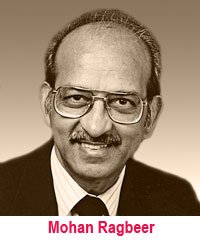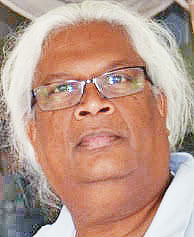Opinions
Déjà vu

In 2016, Canada imported nearly US$1B of dairy products, over half from the USA, to which it exported US$165M, giving the US a trade advantage of some $300M. This underlines Trump’s inaccuracies, one of the many being his insistence that America is badly treated by Canada. I would urge him to read the NAFTA Ch. 11 cases.
China, Canada, India and the EU retaliated promptly, dollar for dollar, timed in step with the USA. They are limited however in how much impact they will have, by the smaller scale of their imports relative to the flow of goods from the USA, some four times greater, in the case of China. Its list is some 600 items long, make up 22.5% of its imports from the USA, and includes auto and aircraft products, natural gas, crude oil, cotton and soybeans, the last a major export to China. The EU list includes jeans, motorcycles and whiskey. India, where owning a Harley-Davidson (HD) has become a status symbol, has imposed a tariff of 50% on all motorcycles over 800cc displacement, which Trump claims resulted from his intercession. HD has decided to manufacture some motorcycles in Europe, earning Trump’s wrath and threats. Remember that Trump had praised HD as a model corporate American.
Trump’s economic advisers, Stephen Moore and Larry Ludlow, share their boss’s confidence in the tax moves, noting the positive effects of lowered domestic tax rates on the US economy, although recognising the economic cost of tariffs: raising cost of materials for the manufactures he wants to stimulate, which will raise the cost of production e.g. steel sinks, airplanes, aluminum vessels, and increase prices, which tend to lower sales, costing jobs and be inflationary.
Tariffs can be a double-edged sword. They should recall that Obama between 2009 and 2012 slapped duties on Chinese tyres on an annual sliding scale, 55%, then 45%, 35% and so on. The measure did save 1200 jobs but at great cost.
The Peterson Institute of Washington DC, reported in 2012: “American buyers of cars and light trucks pay a hefty price for this exercise in trade protection …the total cost to American consumers from higher prices (for tyres)… was around $1.1bn in 2011. The cost per job manufacturing saved was at least $900,000 in that year. Only a small fraction of that bloated figure reached the pockets of the workers. ..most of the money landed in the coffers of the companies…” The additional cost of tyres reduced consumer spending on general retail, lowered employment, and cost many jobs: “it seems likely that protectionism cost the US economy around 2531 jobs.” Additionally, the US lost $1billion as China imposed anti-dumping duties on chicken parts. The tyre tariff ended in 2012, with less fanfare than its start.
Similar adventures were embarked on by Raegan when he targeted steel, automobiles and semiconductor technology and slapped 100% duties on Japan in an effort to set things right. Japan did not object and made voluntary adjustments, and eventually established car plants in the NAFTA area.
For Canada, this is also an eye-opener, pro-NAFTA Trudeau forced into more Canada-centred actions as his Foreign Minister lectures steel-workers in Hamilton, who have been clobbered again. Trump’s actions are fiercely nationalistic, fashioned by his mercantilist friends, and will enrich many. This too will pass.
Meanwhile, another mass killing unsettles the nation, this time in Annapolis, Maryland, next door to Washington DC.
I hope you had a happy Canada Day.
Finessing to a roar of lawnmowers
 Romeo Kaseram
Romeo Kaseram
It is not the position and angle of the sun in the sky that makes it summer. It is when that cut-grass smell filters into the house behind the roar of lawnmowers. It is this drone of industry that arrives first, the humming of engines distant like a hive of bees driven, purposeful, bereft of poetry, wholly absorbed with the quotidian and mundane. Soon the cut-grass smell arrives, and with this a reminder of the absence of scents in our outdoor world during the harshest of the winter months; that despite what some folks say when they sniff the air and proclaim with certainty they can smell coming precipitation from the cold-grey
and snow-laded sky, winter is less about the fresh irony scent of snow blankets and a new coat of ice, and more about the touch, and taste, and the bracing bite of an Arctic wind. I welcome the filtering of the cut-grass summer smell into the rooms of the house. I savour how its scent triggers memories of the time when I was a boy growing up back home. My recall of those days was a time when to cut the grass was not to prime a combustion engine on a lawnmower, then to pull its cord, and wait for the cough, splutter, and the catching of the spark so the blade spun in celebration of the mechanical, with the rapturous payback of gratitude for the rekindling of its internal fire being a burnt offering of oil mixed with gasoline.
So I tune out the lawnmower sounds and its misplaced gift of monoxide. Instead, I recall when I was a boy growing up back home, and how the neighbour whetted the silver edge on the blade on the brushing-cutlass. It was an act of precision, the whet-stone traveling in a short arc, the hand lifting and then descending to barely touch the edge of the blade in the circularity of a practiced sweep, the rasping almost symphonic, the air vibrating with the caress of stone on cold iron.
Here is a comparison of the flavour of cheese to an unwholesome dryness of chalk – a lawnmower pushed along on an overgrown front yard, each pass of its wheels accompanied with an inexorable bite of the blade revolving below, driven by its many cogs and gears, the grass-clippings bloating the bag so it shape-shifts into a chimeric mix of a machine along with the giant abdomen of a munching, feeding insect.
But to recall the soft sweep of the brushing-cutlass, each arc a flash in the sun of the silver lining of its whetted edge, the precision of its downward bite centimetres off the grass, the razor actionability of the cut a mix of coordination of hand, eye, and blade, is to simultaneously hear as an accompaniment the alerting calls of blue jays to its entire nation of jays about the erratic presence of grasshoppers. Here the silence of the arcing of the blade of the brushing-cutlass as it sweeps forward causes with each upward lift an accompaniment of flitting as hundreds of grasshoppers respond with a shellac clicking of limbs, as if each insect is being sprung from a catapult.
I find to push the mass of a marauding lawnmower is to remain on the narrow path of predictability; leaning forward, shoulders down, the drive forward must be resolute, programmed, and genetically pre-purposed, as encoded as a busy bee pinned onto a beeline. To look through our front windows into the neighbourhood is to witness the predictability of manicuring, patterns of even swaths cut row after row into front lawns, the horizontality and verticality sometimes varied with a neighbour running oblique straight lines as strips in the uniform grass.
Not so with a brushing-cutlass – to sweep with its edge was to praise each blade of grass for its individuality; in the hands of my expert neighbour back home, the brushing-cutlass was a chisel held by the fingers of an artist standing with an assessing eye, the performance of artistry not only in the sculpting of the landscape hidden inside the marble, but also in the very act of shaping itself, in the fluidity of the sweep as the cutting blade was guided by the arm, and in the finessing of the finish imparted from the wrist.
It is my recall of moments as these where I understand the world before me is now a mechanical one, where to cut the grass on an early summer morning is to be driven by the rapidity of completing one chore from another, until there is no daylight left. To stop by the roses is not to drink from its ethereal beauty, to pause with the eyes to celebrate its texture; instead, it is to be assessed for rust and infection.
Such is the angle from which we view the world today – through an intersectionality of the quotidian and mechanical, so summer takes shape through priming a combustion engine before cutting the grass. I always return back home to the recall of awakening to the silence broken by a brushing-cutlass’ finessing sibilance.
